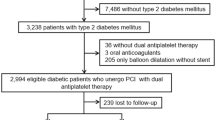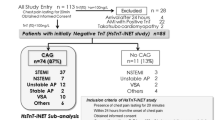Abstract
The study aimed to assess the association of high-sensitivity C-reactive protein (hsCRP) and N-terminal pro-brain natriuretic peptide (NT-proBNP) to major adverse cardiovascular events (MACE) in Takayasu arteritis (TA) patients with coronary artery disease (CAD). Data on 60 TA patients with CAD and 60 age- and severity-matched patients with CAD hospitalized in Fuwai Hospital from 2005 to August 2014 were assessed. The clinical features, laboratory data, coronary angiographic findings, treatment, and follow-up outcomes were summarized retrospectively. MACE were defined as death from cardiac causes, myocardial infarction, nonfatal target vessel revascularization, or rehospitalization due to unstable or progressive angina. CAD patients had more atherogenic lipid and lipoprotein profiles such as lower levels of high-density lipoprotein cholesterol (HDL-C) (1.0 ± 0.2 vs. 1.3 ± 0.3 mmol/L, p = 0.01) and higher levels of low-density lipoprotein cholesterol (LDL-C) (2.5 ± 0.9 vs. 2.2 ± 1.1 mmol/L, p = 0.04) in contrast with TA-CAD patients. During a mean follow-up period of 3.2 years, 31 patients with Takayasu coronary arteritis reached the endpoint. Multivariate Cox proportional hazards model demonstrated that log(hsCRP) (HR = 5.3, 95 % CI = 1.1–27.8, p = 0.04) was a significant and independent predictor of MACE in patients with Takayasu coronary arteritis. Elevated baseline levels of hsCRP predict cardiovascular events, independent of other prognostic markers in TA-related CAD patients.
Similar content being viewed by others
References
Subramanyan R, Joy J, Balakrishnan KG (1989) Natural history of aortoarteritis (Takayasu’s disease). Circulation 80:429–437
Rav-Acha M, Plot L, Peled N, Amital H (2007) Coronary involvement in Takayasu’s arteritis. Autoimmun Rev 6:566–571
Lanjewar C, Kerkar P, Vaideeswar P, Pandit S (2007) Isolated bilateral coronary ostial stenosis-An uncommon presentation of aortoarteritis. Int J Cardiol 114:e126–e128
Lee K, Kang WC, Ahn T, Moon CI, Han SH, Shin EK et al (2010) Long-term outcome of drug-eluting stent for coronary artery stenosis in Takayasu’s arteritis. Int J Cardiol 145:532–535
Ando M, Sasako Y, Okita Y, Tagusari O, Kitamura S, Matsuo H (2000) Surgical considerations of occlusive lesions associated with Takayasu’s arteritis. Jpn J Thorac Cardiovasc Surg 48:173–179
Pearson TA, Mensah GA, Alexander RW, Anderson JL, Cannon-Ro CM III, Criqui M et al (2003) Markers of inflammation and cardiovascular disease: application to clinical and public health practice: a statement for healthcare professionals from the Centers for Disease Control and Prevention and the American Heart Association. Circulation 107:499–511
Morrow DA, Cannon CP, Jesse RL, Newby LK, Ravkilde J, Storrow AB et al (2007) National Academy of Clinical Biochemistry Laboratory Medicine Practice Guidelines: clinical characteristics and utilization of biochemical markers in acute coronary syndromes. Circulation 115:e356–e375
Yin WH, Chen JW, Jen HL, Chiang MC, Huang WP, Feng AN et al (2004) Independent prognostic value of elevated high-sensitivity C-reactive protein in chronic heart failure. Am Heart J 147:931–938
Ridker PM, Hennekens CH, Buring JE, Rifai N (2000) C-reactive protein and other markers of inflammation in the prediction of cardiovascular disease in women. N Engl J Med 342:836–843
Daniels LB, Maisel AS (2007) Natriuretic peptides. J Am Coll Cardiol 50:2357–2368
Sabatine MS, Morrow DA, de Lemos JA, Gibson CM, Murphy SA, Rifai N et al (2002) Multimarker approach to risk stratification in non-ST elevation acute coronary syndromes: simultaneous assessment of troponin I, C-reactive protein, and B-type natriuretic peptide. Circulation 105:1760–1763
Maeda K, Tsutamoto T, Wada A, Mabuchi N, Hayashi M, Tsutsui T et al (2000) High levels of plasma brain natriuretic peptide and interleukin-6 after optimized treatment for heart failure are independent risk factors for morbidity and mortality in patients with congestive heart failure. J Am Coll Cardiol 36:1587–1593
Wang TJ, Larson MG, Levy D, Benjamin EJ, Leip EP, Omland T et al (2004) Plasma natriuretic peptide levels and the risk of cardiovascular events and death. N Engl J Med 350:655–663
Kistorp C, Raymond I, Pedersen F, Gustafsson F, Faber J, Hildebrandt P (2005) N-terminal pro-brain natriuretic peptide, C-reactive protein, and urinary albumin levels as predictors of mortality and cardiovascular events in older adults. JAMA 293:1609–1616
Yasue H, Yoshimura M, Sumida H, Kikuta K, Kugiyama K, Jougasaki M et al (1994) Localization and mechanism of secretion of B-type natriuretic peptide in comparison with those of A-type natriuretic peptide in normal subjects and patients with heart failure. Circulation 90:195–203
Valgimigli M, Serruys PW, Tsuchida K, Vaina S, Morel MA, van den Brand MJ et al (2007) Cyphering the complexity of coronary artery disease using the syntax score to predict clinical outcome in patients with three-vessel lumen obstruction undergoing percutaneous coronary intervention. Am J Cardiol 99:1072–1081
Chakravarty T, Buch MH, Naik H, White AJ, Doctor N, Schapira J et al (2011) Predictive accuracy of SYNTAX score for predicting long-term outcomes of unprotected left main coronary artery revascularization. Am J Cardiol 107:360–366
Caixeta A, Généreux P, Palmerini T, Lansky AJ, Mehran R, Dangas GD et al (2014) Prognostic utility of the SYNTAX score in patients with single versus multivessel disease undergoing percutaneous coronary intervention (from the Acute Catheterization and Urgent Intervention Triage StrategY [ACUITY] trial). Am J Cardiol 113:203–210
Arend WP, Michel BA, Bloch DA, Hunder GG, Calabrese LH, Edworthy SM et al (1990) The American College of Rheumatology 1990 criteria classification of Takayasu arteritis. Arthritis Rheum 33:1129–1134
Sianos G, Morel MA, Kappetein AP, Morice MC, Colombo A, Dawkins K et al (2005) The SYNTAX Score: an angiographic tool grading the complexity of coronary artery disease. Eurointervention 1:219–227
Cutlip DE, Windecker S, Mehran R, Boam A, Cohen DJ, van Es GA et al (2007) Clinical end points in coronary stent trials: a case for standardized definitions. Circulation 115:2344–2351
Park SH, Chung JW, Lee JW, Han MH, Park JH (2001) Carotid artery involvement in Takayasu’s arteritis: evaluation of the activity by ultrasonography. J Ultrasound Med 20:371–378
Wang X, Chen B, Lv N, Liu Q, Dang A (2014) Association of abnormal lipid spectrum with the disease activity of Takayasu arteritis. Clin Rheumatol. [Epub ahead of print]
Olsen MH, Christensen MK, Hansen TW, Gustafsson F, Rasmussen S, Wachtell K et al (2006) High-sensitivity C-reactive protein is only weakly related to cardiovascular damage after adjustment for traditional cardiovascular risk factors. J Hypertens 24:655–661
Soto ME, Espinola-Zavaleta N, Ramirez-Quito O, Reyes PA (2006) Echocardiographic follow-up of patients with Takayasu’s arteritis: five-year survival. Echocardiography 23:353–360
Ishikawa K, Maetani S (1994) Long-term outcome for 120 Japanese patients with Takayasu’s disease. Clinical and statistical analyses of related prognostic factors. Circulation 90:1855–1860
Iga K, Gohma I, Hori K (1991) Regression of the left main trunk lesion by steroid administration in Takayasu’s aortitis. Chest 99:508–510
Ishikawa K (1991) Effects of prednisolone therapy on arterial angiographic features in Takayasu’s disease. Am J Cardiol 68:410–413
Soeiro Ade M, Almeida MC, Torres TA, Franken M, Lima FG, Ganem F et al (2013) Clinical characteristics and long-term outcome of patients with acute coronary syndromes and Takayasu arteritis. Rev Port Cardiol 32:297–302
Olsen MH, Hansen TW, Christensen MK, Gustafsson F, Rasmussen S, Wachtell K et al (2008) Cardiovascular risk prediction by N-terminal pro brain natriuretic peptide and high sensitivity C-reactive protein is affected by age and sex. J Hypertens 26:26–34
Olsen MH, Hansen TW, Christensen MK, Gustafsson F, Rasmussen S, Wachtell K et al (2005) N-terminal pro brain natriuretic peptide is inversely related to metabolic cardiovascular risk factors and the metabolic syndrome. Hypertension 46:660–666
Almagor M, Keren A, Banai S (2003) Increased C-reactive protein level after coronary stent implantation in patients with stable coronary artery disease. Am Heart J 145:248–253
Hong MK, Park SW, Lee CW, Kim YH, Kim JH, Song JM et al (2003) Prospective comparison of coronary artery remodeling between acute coronary syndrome and stable angina in single-vessel disease: correlation between C-reactive protein and extent of arterial remodeling. Clin Cardiol 26:169–172
Pucci A, Brscic E, Tessitore E, Celeste A, Crudelini M, De Bernardi A et al (2008) C-reactive protein and coronary composition in patients with percutaneous revascularization. Eur J Clin Invest 38:281–289
Lupi-Herrera E, Sánchez-Torres G, Marcushamer J, Mispireta J, Horwitz S, Vela JE (1977) Takayasu’s arteritis. Clinical study of 107 cases. Am Heart J 93:94–103
Yokota K, Shimpo M, Iwata T, Hirose M, Ikemoto T, Ohya K et al (2012) A case of Takayasu arteritis with repeated coronary artery restenosis after drug-eluting stent implantation successfully treated with a combination of steroids. Intern Med 51:739–743
Disclosures
None.
Author information
Authors and Affiliations
Corresponding author
Rights and permissions
About this article
Cite this article
Wang, X., Dang, A., Lv, N. et al. High-sensitivity C-reactive protein predicts adverse cardiovascular events in patients with Takayasu arteritis with coronary artery involvement. Clin Rheumatol 35, 679–684 (2016). https://doi.org/10.1007/s10067-015-2873-6
Received:
Revised:
Accepted:
Published:
Issue Date:
DOI: https://doi.org/10.1007/s10067-015-2873-6




